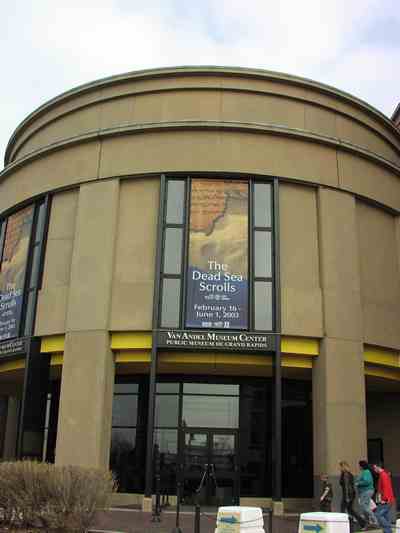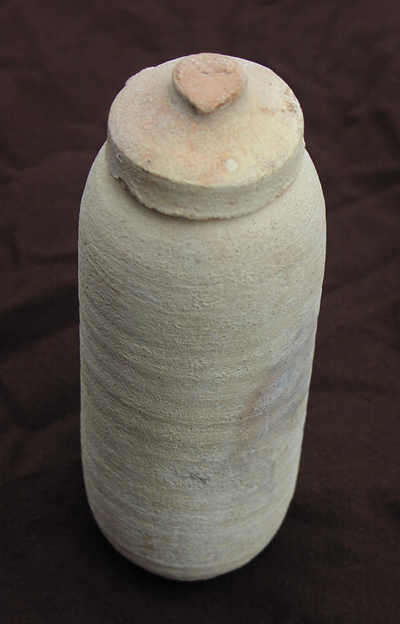Picture Album: Dead Sea Scrolls Exhibit

Dead Sea Scrolls at Public Museum, Grand Rapids
Our Messianic Assembly had the distinct opportunity to visit the Dead Sea Scrolls exhibit presented at the Public Museum of Grand Rapids, Michigan during 2003. Our understanding of the life and times of the Messiah, Yeshua, was enhanced, and we share here the highlights of our learning during that visit. The Dead Sea Scrolls from the Qumran Community are the oldest original Biblical manuscripts in existence today, and are a thousand years older than the Alepo and st. Petersburg texts. These documents are almost identical. The Dead Sea Scrolls include three types of documents: Halakh (Old Testament) Scriptures including every book of the Hebrew Bible except Esther, Apocryphal books including Tobit, Sirach, and the Letter of Jeremiah, and Pseudepigrapha including Enoch, Jubilee, and the Testament of the Twelve Patriarchs. Over 900 texts were fond in 11 caves, 80% written on parchment and 20% on papyrus. In the 1950's, Father DeVaux and a team of 8 scholars worked on organizing and translating the texts, which were in thousands of pieces and had to be restored like a giant jigsaw puzzle.
The Dead Sea Scrolls: The Brazen Altar

One of our goals in visiting the exhibit was to examine the validity and integrity of the documents and learn more about them.
Two of our members who visited are students of modern and Paleo-Hebrew. Upon inspection of the style, character, and accuracy of the scrolls, their verdict was that these are indeed genuine copies according to knowledge. Their investigation was also for the purpose of determining the significance of this exhibit for the common believer. The exhibit stirred up not only questions but many answers, as well.
Qumran Community: The Dead Sea Region

The Qumran Community were Essenes. The ancient writer Pliny the Elder (23-79 A.D.) referred to them in his "Natural History" as a "solitary tribe" living on the west coast of the Dead Sea.
Flavius Josephus (37-100 A.D.) in his "Jewish War" described Essene life minutely including ritual meals and even toilet habits. They referred to themselves simply as the Yahad (Community) and 'edah (Assembly). Some of their differences with the Pharisees and Sadducees of the day included interpretations of the Temple, worship, purity, and calendar disagreements.
Essenes: Comparisons with New Testament Church

Surprising similarities were found with the New Testament church.
Both teach that the faithful are in a "New Covenant" with Yah. The Essenes emphasized the importance they placed on "miqva'ot" or ritual baths, which they performed several times each day. These have their counterpart in the Christian sacrament of baptism. The important communal ritual meal, which could only include the faithful, finds its counterpart in the New Testament Last Supper similarly referred to as "Communion." The Essenes practiced prayer as a substitute for sacrifice (a New Testament theme as well), and the study of Sacred texts consumed one-third of every night. A solar calendar of 364 days was used (similar to us today) instead of the lunar-based calendar of the Saducees and Pharisees. White robes were their only outer clothing, a theme found in the New Testament as the clothing of the resurrected saints. Similar to the Apostle Paul's epistles (Romans 5, etc.), the Essenes used the term "the many" for the entire faithful community. Predestinatin was taught, similar to the Newe Testament, which states that Yah predestinates all things by the council of His Will. Community of property was practiced, similar to the New Testament ideal, which was put into force for a time during the New Testament church. A belief in the "end times" was also central to Essenes as well as Christians.
Essene beliefs: Two Messiahs

Both Essenes and Christians are waiting for a coming Messiah. The Essenes, in fact, believed that there were TWO MESSIAHS coming, one in the spirit of Joseph and one in the spirit of Judah.
The New Testament presents these as TWO COMINGS of the one Messiah. The Patriarch Joseph had been accosted and left in a pit to die while his brethren tore his clothes and smeared the garments with blood; this is perfect symbolism for Messiah's forst coming and sacrifice at the hands of His own people. The patriarch Judah, symbolized as a lion (Num. 1 & 2) is a perfect symbol of Messiah's victorious Second Coming as a conquering Savior putting His enemies under His feet. (I Cor. 15)
How We Worship: The Two Houses of Israel

This also points up the importance of the symbolism of the TWO HOUSES of Israel, ten-tribe Ephraim and two-tribe Judah. Ephraim, son of Joseph, was depicted as an ox, a symbol of sacrifice. Judah was depicted as a lion, the king of the forest. When ancient Israel divided into two separate nations and kingdoms after the time of Solomon, this was Yah's doing, for He was showing in Old Testament typology the work that the coming Messiah would perform.
The nation of ten-tribe Ephraim was conquered by Assyria in 832-676 B.C. in four invasions, and scattered to other lands, becomig the "lost sheep of the house of Israel." (Matt. 10:5-6; 15:24) We believe that theirdescendants have joined with other peoples to become the Christian nations of the world today. The nation of Judah, comprising the tribes of Judah and Benjamin, was taken into Babylonian captivity for 70 years before returning to Canaan.
How We Worship: Uniting Israel's Two houses

The Essene's Nahum Commentary says that Judaism was divided into Three groups: Ephraim, Manasseh, and Judah. This also indicates their understanding that there was indeed a continuing division between the Ten Tribes (Ephraim and Manasseh, the sons of Joseph), and the Two Tribes (Judah and Benjamin). The prophecy of the two sticks in Ezekiel 37:15-29 makes it clear that the two houses of Israel will be rejoined at the end of this age, a time that is even now drawing near! May you be blessed through your study of Yah's Holy Word!
Our Worship Service: What You Will Experience!
O' give thanks to YHVH. Call upon His name. Make known His deeds among the people. Sing to Him. Sing psalms to Him. Speak of all His wondrous works. (Psalm 105:1-2)
Other articles on this page discussed the name of Bet Yeshurun Assembly (BYA), its nature, authority, reputation, character and how BYA worships in spirit and truth as Yahushuah commands. This article further examines how the worship services of BYA are based upon scripture. Choose the button below to read about the format of our weekly Sabbath service!
Service FormatWhat We Believe
Elohim
We believe in the One true Divine El of Israel, the Almighty Elohim of Abraham, Isaac, and Jacob. His name in Hebrew is YHWH, often written "Yahweh" or "Yahuah" and means the Everliving One.
The Bible
The Scriptures are the divine revelation and revealed Will of YHWH, focusing on His Son, Yahushuah (called in mainstream religion "Jesus Christ").
The Messiah
Yahushuah is the Son of our Heavenly Father (YHWH). He was the giver of Torah and is the fulfillment of Torah. He is the only way of salvation for mankind. (Acts. 4:12) See our list of Messianic prophecies.
The Holy Spirit
The Ruach ha'Kodesh, or Holy Spirit, has the essence, power, and mind of YHWH, and makes believers begotten children of the Kingdom of YAH.
Salvation
Man has no hope for eternal life within himself. He is dependent upon the grace of the Savior and redeemer to be saved. This is done by the indwelling of the Holy Spirit in the mind and soul of man.
The Everlasting Kingdom
The Kingdom of Elohim is an everlasting kingdom based upon the Sovereignty of Yah as its King. The kingdom of Yah will eventually encompass the whole of creation. (Rom. 8:20-21; Rev. 5:13)
Divine Laws
Yah's laws are Spiritual, everlasting, merciful, righteous, and holy. The laws of Elohim are the true liberation of men upon the earth. We must live by every Word of Yah. (Luke 4:4) Yah's Divine law applies to us living today under the New and Better Covenant.
The Gospel
The duty of believers is to carry the Gospel message, or Good News, to all nations, kindreds, and tongues. This message consists of the truth of: a) Yahushuah's literal return to reign on this earth; b) the grace and justification of Yah; c) sanctification or holiness through His Word and Spirit. d) Yahushuah is the only Savior of mankind.
